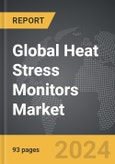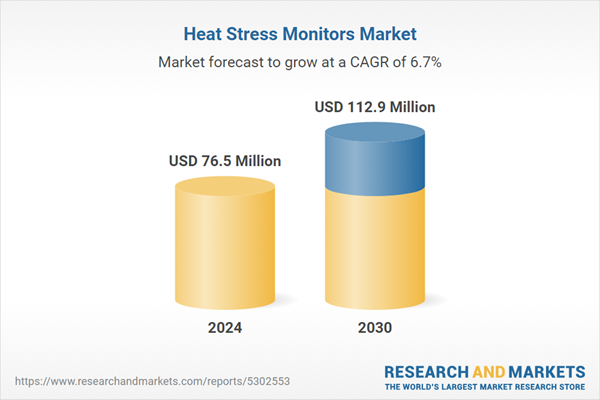The global market for Heat Stress Monitors was valued at US$76.5 Million in 2024 and is projected to reach US$112.9 Million by 2030, growing at a CAGR of 6.7% from 2024 to 2030. This comprehensive report provides an in-depth analysis of market trends, drivers, and forecasts, helping you make informed business decisions. The report includes the most recent global tariff developments and how they impact the Heat Stress Monitors market.
Segments: Product Type (Handheld, Fixed / Portable); End-Use (Mining & Oil & Gas, Manufacturing Plants, Athletics & Sports, Military, Other End-Uses).
Geographic Regions/Countries: World; United States; Canada; Japan; China; Europe (France; Germany; Italy; United Kingdom; Spain; Russia; and Rest of Europe); Asia-Pacific (Australia; India; South Korea; and Rest of Asia-Pacific); Latin America (Argentina; Brazil; Mexico; and Rest of Latin America); Middle East (Iran; Israel; Saudi Arabia; United Arab Emirates; and Rest of Middle East); and Africa.
The analysts continuously track trade developments worldwide, drawing insights from leading global economists and over 200 industry and policy institutions, including think tanks, trade organizations, and national economic advisory bodies. This intelligence is integrated into forecasting models to provide timely, data-driven analysis of emerging risks and opportunities.
Global Heat Stress Monitors Market - Key Trends and Drivers Summarized
Why Are Heat Stress Monitors Crucial for Worker Safety and Health?
Heat stress monitors are becoming increasingly important as awareness of occupational health and safety grows, particularly in industries where workers are exposed to extreme heat. These devices monitor environmental conditions such as temperature, humidity, and heat index to assess the risk of heat-related illnesses like heat stroke and dehydration. Heat stress is a critical concern in sectors such as construction, mining, manufacturing, and agriculture, where workers often perform strenuous tasks in high-temperature environments. As global temperatures rise and extreme weather conditions become more frequent due to climate change, the demand for heat stress monitoring devices has surged. These monitors help employers ensure compliance with safety regulations, protect workers, and mitigate the risks associated with heat exposure.How Is Technology Influencing the Heat Stress Monitor Market?
Technological advancements have significantly enhanced the accuracy and functionality of heat stress monitors. Modern devices now come equipped with wireless sensors, real-time data analytics, and cloud connectivity, allowing for continuous monitoring of environmental conditions and timely alerts when thresholds are exceeded. The integration of wearable technology, such as wristbands and smart clothing, has made heat stress monitoring more personal and accessible, providing real-time data on individual worker’s exposure to heat. AI and machine learning are also being applied to predict potential heat stress scenarios based on historical data and environmental trends, enabling proactive safety measures. In addition to monitoring ambient conditions, some devices can track physiological responses such as heart rate and hydration levels, offering a comprehensive view of a worker’s heat exposure.How Are Market Segments Shaping the Heat Stress Monitor Industry?
Product types include handheld monitors, fixed systems, and wearable devices, with wearable monitors gaining popularity due to their convenience and ability to provide continuous, personalized data. Sensor types range from temperature and humidity sensors to multi-functional devices that also monitor factors like wind speed and solar radiation. Applications of heat stress monitors are found in industrial, military, and athletic environments, with the industrial sector accounting for the largest market share due to the high risk of heat-related illnesses in outdoor and high-heat work environments. The military is another key user, particularly in regions with harsh climates where soldiers are at risk of heat exposure during training or operations.What Factors Are Driving the Growth in the Heat Stress Monitor Market?
The growth in the heat stress monitor market is driven by several factors, including increasing awareness of workplace safety, stringent government regulations on occupational health, and the growing impact of climate change. Employers in high-risk industries are increasingly adopting heat stress monitors to ensure compliance with safety standards set by organizations such as OSHA (Occupational Safety and Health Administration). Rising global temperatures and the frequency of heatwaves have also made heat stress monitoring a critical tool for preventing heat-related illnesses and fatalities. Technological advancements, such as the integration of AI and wearable technology, have further fueled market growth by providing more accurate and user-friendly solutions. Additionally, the expansion of industries such as construction, mining, and manufacturing in emerging economies has increased the demand for heat stress monitors as a safety measure.Report Scope
The report analyzes the Heat Stress Monitors market, presented in terms of units. The analysis covers the key segments and geographic regions outlined below.Segments: Product Type (Handheld, Fixed / Portable); End-Use (Mining & Oil & Gas, Manufacturing Plants, Athletics & Sports, Military, Other End-Uses).
Geographic Regions/Countries: World; United States; Canada; Japan; China; Europe (France; Germany; Italy; United Kingdom; Spain; Russia; and Rest of Europe); Asia-Pacific (Australia; India; South Korea; and Rest of Asia-Pacific); Latin America (Argentina; Brazil; Mexico; and Rest of Latin America); Middle East (Iran; Israel; Saudi Arabia; United Arab Emirates; and Rest of Middle East); and Africa.
Key Insights:
- Market Growth: Understand the significant growth trajectory of the Handheld segment, which is expected to reach US$70.9 Million by 2030 with a CAGR of a 7.8%. The Fixed / Portable segment is also set to grow at 5.0% CAGR over the analysis period.
- Regional Analysis: Gain insights into the U.S. market, valued at $20.0 Million in 2024, and China, forecasted to grow at an impressive 9.9% CAGR to reach $26.3 Million by 2030. Discover growth trends in other key regions, including Japan, Canada, Germany, and the Asia-Pacific.
Why You Should Buy This Report:
- Detailed Market Analysis: Access a thorough analysis of the Global Heat Stress Monitors Market, covering all major geographic regions and market segments.
- Competitive Insights: Get an overview of the competitive landscape, including the market presence of major players across different geographies.
- Future Trends and Drivers: Understand the key trends and drivers shaping the future of the Global Heat Stress Monitors Market.
- Actionable Insights: Benefit from actionable insights that can help you identify new revenue opportunities and make strategic business decisions.
Key Questions Answered:
- How is the Global Heat Stress Monitors Market expected to evolve by 2030?
- What are the main drivers and restraints affecting the market?
- Which market segments will grow the most over the forecast period?
- How will market shares for different regions and segments change by 2030?
- Who are the leading players in the market, and what are their prospects?
Report Features:
- Comprehensive Market Data: Independent analysis of annual sales and market forecasts in US$ Million from 2024 to 2030.
- In-Depth Regional Analysis: Detailed insights into key markets, including the U.S., China, Japan, Canada, Europe, Asia-Pacific, Latin America, Middle East, and Africa.
- Company Profiles: Coverage of players such as Besantek, Extech Instruments, Flir Systems, General Tools & Instruments, LSI LASTEM s.r.l. and more.
- Complimentary Updates: Receive free report updates for one year to keep you informed of the latest market developments.
Some of the 37 companies featured in this Heat Stress Monitors market report include:
- Besantek
- Extech Instruments
- Flir Systems
- General Tools & Instruments
- LSI LASTEM s.r.l.
- Nielsen-Kellerman
- Numag Data Systems Pvt., Ltd.
- PCE instruments
- REED Instruments
- Romteck Australia Pty Ltd
- Runrite Electronics
- SCADACore
- SCARLET TECH
- skSATO (SATO KEIRYOKI MFG. CO., LTD.)
- Sper Scientific
Tariff Impact Analysis: Key Insights for 2025
Global tariff negotiations across 180+ countries are reshaping supply chains, costs, and competitiveness. This report reflects the latest developments as of April 2025 and incorporates forward-looking insights into the market outlook.The analysts continuously track trade developments worldwide, drawing insights from leading global economists and over 200 industry and policy institutions, including think tanks, trade organizations, and national economic advisory bodies. This intelligence is integrated into forecasting models to provide timely, data-driven analysis of emerging risks and opportunities.
What’s Included in This Edition:
- Tariff-adjusted market forecasts by region and segment
- Analysis of cost and supply chain implications by sourcing and trade exposure
- Strategic insights into geographic shifts
Buyers receive a free July 2025 update with:
- Finalized tariff impacts and new trade agreement effects
- Updated projections reflecting global sourcing and cost shifts
- Expanded country-specific coverage across the industry
Table of Contents
I. METHODOLOGYII. EXECUTIVE SUMMARY2. FOCUS ON SELECT PLAYERSIII. MARKET ANALYSISSOUTH KOREAREST OF ASIA-PACIFICARGENTINABRAZILMEXICOREST OF LATIN AMERICAIRANISRAELSAUDI ARABIAUNITED ARAB EMIRATESREST OF MIDDLE EASTIV. COMPETITION
1. MARKET OVERVIEW
3. MARKET TRENDS & DRIVERS
4. GLOBAL MARKET PERSPECTIVE
UNITED STATES
CANADA
JAPAN
CHINA
EUROPE
FRANCE
GERMANY
ITALY
UNITED KINGDOM
SPAIN
RUSSIA
REST OF EUROPE
ASIA-PACIFIC
AUSTRALIA
INDIA
LATIN AMERICA
MIDDLE EAST
AFRICA
Companies Mentioned (Partial List)
A selection of companies mentioned in this report includes, but is not limited to:
- Besantek
- Extech Instruments
- Flir Systems
- General Tools & Instruments
- LSI LASTEM s.r.l.
- Nielsen-Kellerman
- Numag Data Systems Pvt., Ltd.
- PCE instruments
- REED Instruments
- Romteck Australia Pty Ltd
- Runrite Electronics
- SCADACore
- SCARLET TECH
- skSATO (SATO KEIRYOKI MFG. CO., LTD.)
- Sper Scientific
Table Information
| Report Attribute | Details |
|---|---|
| No. of Pages | 93 |
| Published | April 2025 |
| Forecast Period | 2024 - 2030 |
| Estimated Market Value ( USD | $ 76.5 Million |
| Forecasted Market Value ( USD | $ 112.9 Million |
| Compound Annual Growth Rate | 6.7% |
| Regions Covered | Global |









